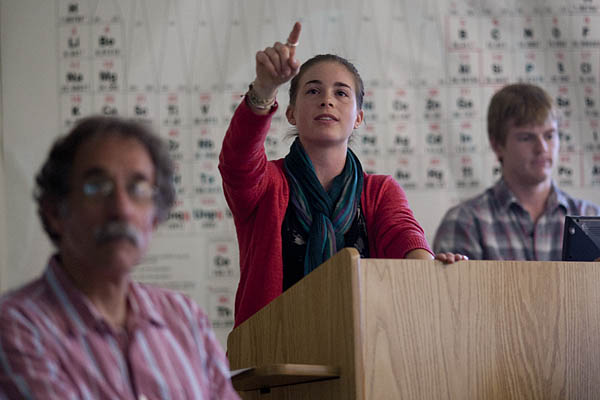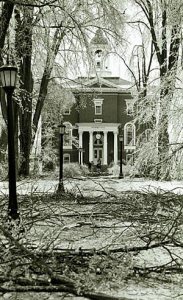
Ice storm can't chill employee spirits
“It’s been nothing short of heroic,” said Vice President for Financial Affairs and Treasurer of the College Peter Fackler about the way Bates folk weathered the historic ice storm. Here’s how some of the heroes saw the College and its neighbors through the crisis.
Chase Pray, a 25-year veteran of dining services and a long-time runner, decided that he wasn’t going to cool his heels for the worst ice storm in New England’s history. Unable to drive to work from his home in Greene because of the ice-caked roads, Pray donned thermal polypropylene, spandex tights and his spiked cross-country racing flats and ran to work at 7 a.m. on Thursday, Jan. 8. He covered nine miles of nearly impassable roads in about an hour and 20 minutes before grabbing a cold shower in Merrill Gymnasium and working a regular eight-hour shift in Commons.
“It was too boring to stay at home. No power, no lights, no nothing,” joked Pray, 53, who logs at least 40 miles each week. “I figured things would be shorthanded, and I’m not one to stay still too long.”
After work on Thursday, Pray spent the night at a friend’s house in Lewiston. Early Friday, he hoofed it back to Greene to make sure his home hadn’t been damaged by downed power lines and tree limbs.
Teaching by propane lantern was the order of the day on Friday for Michael Jones, professor of history. Five of his seven students in a junior-senior seminar showed up in darkened Canham House for an apropos discussion on the decline of the Roman Empire. When asked why he didn’t yield to the adverse teaching conditions, Jones chuckled and said, “Some of it was just perversity.”
Jones had planned to use an overhead projector in the class, but said teaching without power made him realize how much reliance there is on technology to present a class. “I felt like Diogenes holding the lantern up to the blackboard,” he said.
Above the din of roaring hair dryers, Bert Tardif, a plumber in Facility Services, took a short break from thawing pipes at 141 Nichols St. (Office of College Relations) to say that time for sleep had been scarce since the storm’s onset. Between thawing pipes, helping electricians to string cable and checking on gas-powered generators, Tardif and his compatriots worked shifts that defied circadian rhythms. Despite the long hours, he said that their heroic labors weren’t going unnoticed.
“Anytime we came around the corner with a generator, we made a lot of friends,” he said.
Landscape Coordinator Bill Bergevin was seen striding purposefully across the limb-strewn Quad, bearing an ax in each hand. Given the grim determination on his face and his choice of implements, it was decided that questions about the health of campus flora should wait. Bergevin later said that the magnolia next to Hathorn suffered serious wounds during the storm. He plans to wait until spring to determine if the much-beloved landmark must be uprooted. Ninety percent of campus trees sustained significant damage and six more were taken down in the days following the storm as a safety precaution.
On Thursday morning, Pone Vattasso, of dining services, faced a chef’s worst nightmare — no power and a hoard of hungry students, staff and faculty craving a hot breakfast. A Maalox moment? Not for Vattasso, who broke out five 12-inch by 12-inch propane-powered hot plates and — with the help of colleague John Jordan — cooked 2,000 two-egg omelets to order.
Gloria Chadburn, a 15-year veteran of dining services and the Den, holds the unofficial record for the most days holed up at Bates because of the storm. Friday, Jan. 16, marked her ninth day away from her home in Greene because of power outages and frozen pipes. After working 7 a.m. to 3:30 p.m. shifts in the Den, she retired to makeshift living quarters set up for stranded students and employees at 207 Wood St., the Den or Hirasawa Lounge. “Hirasawa has been my presidential suite,” laughed Chadburn.
After Keith Pray and Owen Keene, both of dining services, finished preparing hundreds of pounds of ham, egg and turkey salads for Commons diners, they packaged up quart-sized containers for any staff or faculty member who couldn’t prepare food at home.
Bob Volpi, the environmentally conscious director of dining services, had but one regret about how the storm affected his operation. “Without hot water to wash the dishes, we had to use about 6,000 pieces of paper and plastic. That’s way out of line with our usual environmental standards,” he said.
Director of Facility Services Pat Murphy, like many area residents, found that gas generators were even more scarce than D batteries and lamp oil. Fortunately, four samaritans from Facility Services added their own generators to the power-restoration effort. After using their generators to heat their homes during nights, Clifford Arnold (electrician supervisor), Ron Landry (electrician), Mike Adams (equipment operator) and Rick Lacasse (grounds team leader), hooked theirs up for several full day’s work at Bates.
Neither Bill Bergevin nor Bill St. Pierre, a roofer from Facility Services, had power or heat at their homes. Nonetheless, they asked security for 2 a.m. wake-up calls so they could tend to generators throughout the night. Joining Bergevin and St. Pierre in the round-the-clock gas-and-oil brigade were painting supervisor Dan Sands, painter Steve Morin, mason Wilfred Chouinard and carpenters Tom Winslow, Frank Roy and Brad Gagne.
Aside from devoting long hours to the College, several employees kept a keen eye out for each other and area residents in need. Elaine Freeman, associate director of Facility Services, stopped to offer a ride to Lorraine Brochu, dining services, who — en route to work — was struggling to maneuver across icy Pettengill Street on her hands and knees.
Director of Security and Campus Safety Larry Johnson offered the county United Emergency Management Agency the use of Merrill Gymnasium as a shelter site for anyone without power and heat. But, by the time power was restored to Merrill, Peter Van Gagnon, director of Androscoggin EMA, had selected Lewiston High School and Lewiston’s Multi-Purpose Center as shelter sites. Mattresses were made available to the Lewiston High School shelter, several students volunteered at the Auburn Middle School shelter and the Deansmen and Merimanders sang a cappella at area shelters.
When Laura Biscoe, assistant coordinator of student activities and volunteer coordinator, received a call for help from emergency services in New Gloucester on Thursday, Jan. 15, she mobilized Bob Volpi, Christine Schwartz and Brad Slye of dining services to check on several of the town’s elderly who had been without heat and electricity for more than a week.
The following day, Biscoe and Schwartz took time out from their busy schedules to deliver Bates firewood to local residents. Electrician Paul Szott and painter John Snyder delivered a cord of Bates firewood to needy Buckfield residents, and maintenance coordinator Bob Leavitt did the same for some South China denizens. When the Red Cross contacted Associate Director for Service-Learning Peggy Rotundo for information on sources of seasoned firewood, she and husband Danny Danforth, professor of anthropology, donated half a truckload of their own supply.
Overheard words from Mary Risko, dining services production team leader, revealed the reflex among Bates employees to help others. When Bob Volpi asked her if she needed bottled water or firewood, she said “Make sure everyone else gets what they need first.”
(This story originally appeared in a special issue of the employee newsletter, ReBates, in January 1998.)
— Marc Glass ’88



